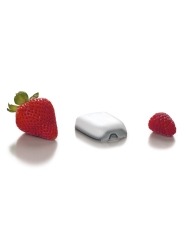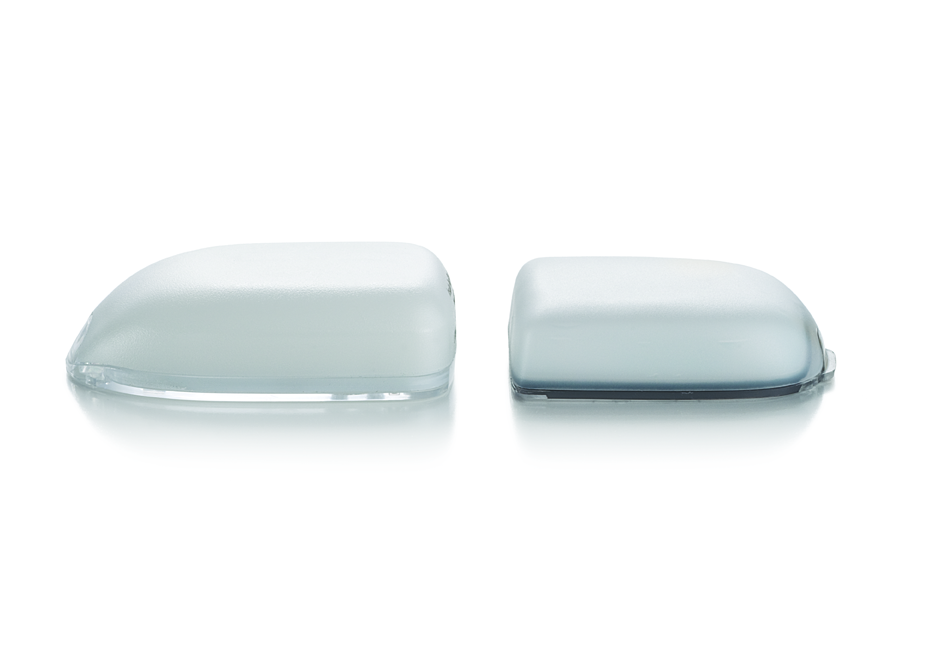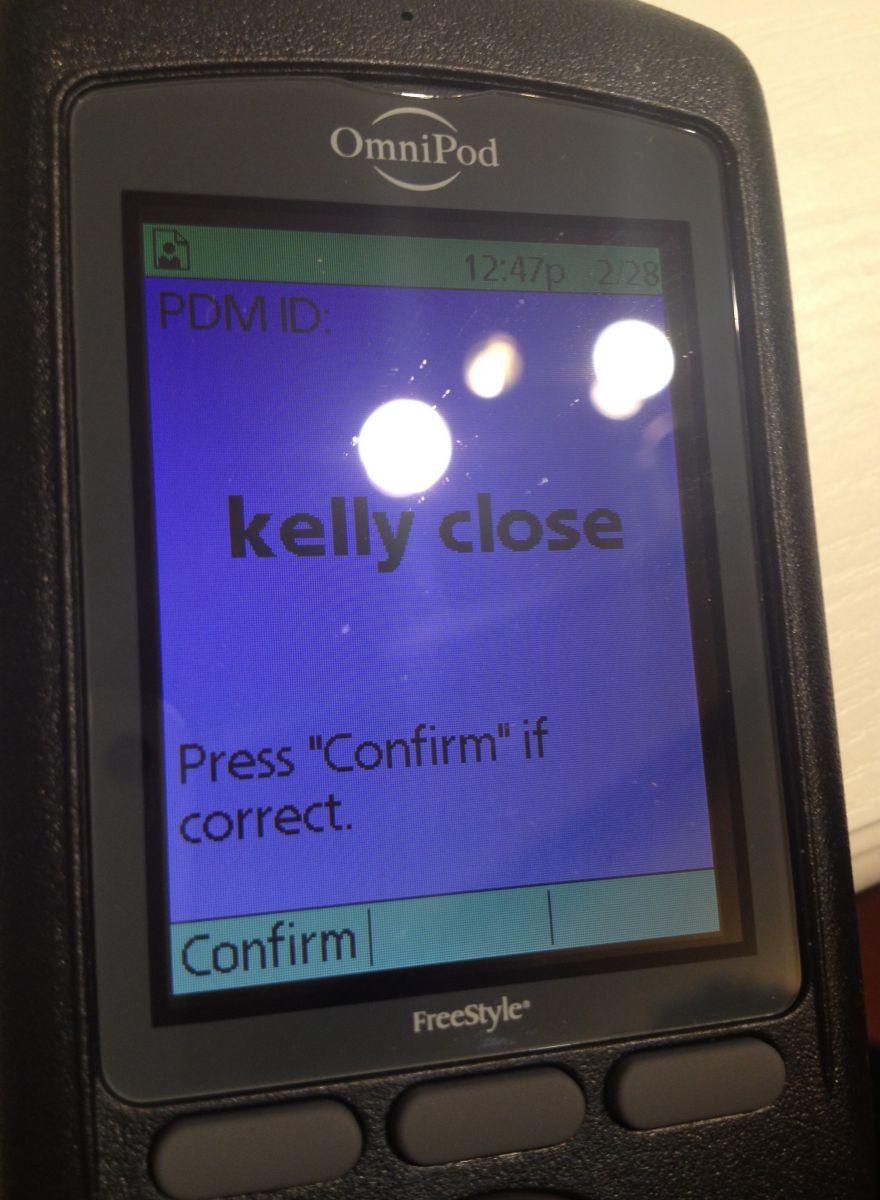Insulet's Second-Generation OmniPod
By Adam BrownKelly Close

by Adam Brown and Kelly Close
The next-generation OmniPod was recently approved in the US – after receiving approval in the EU in 2011 – and we finally got to try it! The next-generation pod has about 2,000 users in the EU and just a few users in the US, as it just began shipping to brand new pumpers last week and will start going to current OmniPod wearers over the next month. (That may not seem fair, but it’s because existing patients will be upgraded when they reorder supplies, meaning they need to use up their old pods first.) This new technology took quite a while to be approved by the FDA – it was originally submitted in May 2011.
What’s new about the second-generation OmniPod?
-
It is MUCH smaller. Specifically, the new OmniPod is an impressive 34% smaller, 25% lighter, and 16% slimmer than its predecessor. Insulet made three key changes to enable this: one less battery, a new reservoir shape, and a refined insertion system. There’s no question that the new OmniPod immediately looked and felt much smaller when we first put it on!
-
The second-generation OmniPod’s handheld controller (“PDM”) has some new “human factor screens” that we were really excited to see (see below). The FDA has placed increasing concern on human factors, and though the regulatory delays are lamentable, they do ensure a safer pumping experience for patients.
-
Insulin-on-board (IOB) now appears on the home screen of the PDM – it’s great to see this front and center, since we both tend to use it so often and it’s annoying to press buttons and track this down in menus. Furthermore, Insulet has added a new feature that breaks insulin-on-board into components: meal and correction. No other pump on the market does this, and we found it useful for getting a much better sense of how insulin-on-board was divvied up.
-
The bolus calculator now uses both correction and meal boluses to calculate IOB. This was a big addition that many patients and healthcare providers have been calling for many years. Previously, only correction boluses were used, meaning IOB did not reflect all the insulin that was truly on board.
-
We both really liked the insertion of the new OmniPod. Compared to infusion sets with durable pumps, the OmniPod’s insertion was already an advantage with the first-generation pump – as a reminder, it is lightning fast (the needle goes in at 1/200 of a second), it is automated and controlled from the PDM, and you can’t actually see the needle. With the new system, the needle is the same size, but feels a little different. According to the company, the needle inserts and retracts using only one spring (it was previously two), which we think makes the insertion much smoother. It is also less noisy – this didn’t bother Kelly before, but sort of bothered Adam – it sounds a little more “happy” now when the pod goes in, where before it sometimes sounded a bit cranky. Once the pod has been inserted, there is now a pink visual confirmation at the top of the pod, just to make triple sure the pod’s insertion mechanism has actuated – “listen, look and feel” said our trainer Rob Campbell (and one of the strategic brainpowers at the company).
-
Experience drives product refinement – Insulet says it has incorporated the experience and learnings from producing close to 20 million pods and the experience of over 40,000 customers to enhance and make improvements in the new pod design.

Primer on human factors – what does this really mean?
-
Human factors mean how we use and interact with things, especially electronics and medical devices (see examples of human factors from the FDA here). The new OmniPod has a number of additions – most are small, but they certainly add up to a big positive overall.
-
You “confirm” your name when the meter goes on – Kelly liked this feature not so much for the confirmation, but in case it gets lost – if anyone turns it on, they may be able to find her! Also, it’s helpful when multiple people are carrying around OmniPod handhelds – you wouldn’t want to accidentally give your FWD (friend with diabetes) a three-unit bolus! This is primarily safety-related we think, but it also adds a touch of personalization. You can also pick the background color on the PDM – she chose purple and Adam liked blue. A small thing, but another nice personalization feature.
-
The PDM has several other confirmation screens, which typically ask the user to confirm an entry was correct. For instance, following input of a meal plus a correction bolus, a final screen will display the amount of insulin.
-
The temporary basal menu is particularly well designed, since this can sometimes be confusing. As you increase or decrease the percentage, the screen notes in words “more insulin” or “less insulin” – this makes it crystal clear what a 50% temporary basal rate actually means.
-
During insertion, the PDM screen displays several pictures to ensure safety and warn patients about anything to watch out for. For instance, when removing the plastic cap covering the insertion mechanism, the PDM shows a picture to make sure the insertion needle is not preemptively coming out of the pod. Although we feel like we can insert an OmniPod in our sleep, this is a valuable addition for new users.
-
One hour following insertion, the OmniPod automatically reminds you to check your blood glucose.
The new OmniPod is priced the same as it has always been – $800 for the PDM and $30 per pod, each pod lasting three days. Insulin pumps are typically covered fairly well by insurance, so many patients will not pay nearly this much. If you are currently on another company’s insulin pump, Insulet also has a program to get a starter kit at a reduced cost. Unfortunately, the OmniPod is not covered by Medicare though Insulet is working with the Centers for Medicare and Medicaid Services to try to obtain coverage.
Current OmniPod users will be upgraded to the new pod for free. Current OmniPod users should start to see the new pods delivered in the next month. Users will be upgraded to the new pod when they reorder supplies.
We think more people will be drawn to pumping and to Insulet’s OmniPod now that it is significantly smaller – to date, about 30% of people with type 1 diabetes and less than 1% of people with type 2 diabetes in the US use insulin pumps. We believe with this enhanced technology and smaller size that more and more people will be attracted to physiologic delivery of insulin, which is the closest we can get, as people with diabetes, to “normal”! A big cheer for the dramatic improvement of this product.







